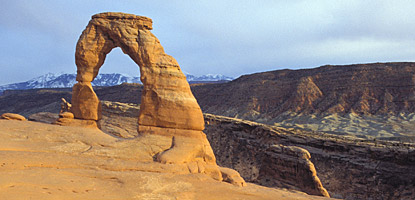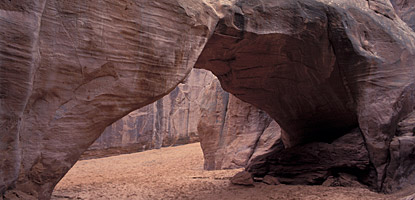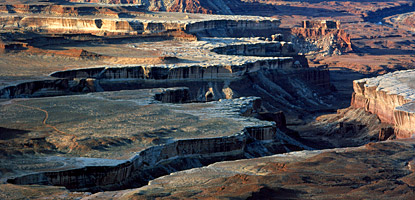COMING SOON HOUSE ADVERTISING ads_leader
We are off to Moab, Utah to see more for our nation's natural wonders, specifically in the beautiful state of Utah. Moab boasts both Canyonlands and Arches National Parks within easy reach. Did you know Moab got its name from the Biblical name for a land that is just short of the Promised Land? It was the Mormon settler's in the 1800's that gave this beautiful area its name. There are 137 Bible verses where Moab is named.
Arches National Park has over 2000 natural sandstone arches. The most famous is Delicate Arch, seen in countless photos and advertisements. The forces of nature for millions of years creates a unique and breathtaking scene. But no evidence of dwellings in Arches has ever been found. The first reliable date for Arches is June 9, 1844, by a Denis Julien, a French American trapper who had a habit of chiseling his name and date onto rocks in the Southwest. Before that, various Native American tribes inhabited the region, followed by the Spaniards.

Delicate Arch
Arches were formed by the combination of nature and time, with rock layers that reveal millions of years of erosion, deposition, and
other geologic events. Arches is located in the high desert, with elevations that range from 4000 to 5600 feet. Hot in the summer, cold in the winter, very little rainfall, temperatures can fluctuate over 50 degrees in a day.
Much like most desert areas, the land appears harsh and unchanging. But the desert ecosystem is constantly evolving with weather, climate shifts, and geologic activity. Pollution has made an impact on natural resources, and introduced new species.

Sand Dune Arch
The arches are the park's most outstanding natural feature. Of the over 2000 catalogued arches, they vary in size from a 3 foot (minimum to be considered an arch) opening to 306 feet for Landscape Arch.
Canyonlands National Park area has been visited for over 10,000 years. Many different people have moved in and out of the area, depending on the availability of natural resources. Canyonlands is one of the last undisturbed areas of the Colorado plateau. The area is high desert, similar to the weather and rainfall in Arches National Park.
Two unusual natural features are common here. Biological soil crust is a living groundcover that forms the
foundation of high desert plant life. And ephemeral potholes are naturally occurring basins in sandstone that collect rain and sediment. The potholes foster the growth of organisms that can survive long periods of dehydration. It becomes the breeding ground for many high desert amphibians and insects.

Ephemeral Pools
Over time, Canyonlands was flooded by oceans, covered by rivers, and mudflats, and eventually covered with sand. Layer upon layer of sedimentary rock formed as buried materials became encased by the precipitates in ground water. Each layers reveals a different environment. Equally surprising is that each layer was flat when deposited.

Green River Overlook
Naturally, Moab itself offers plenty to do as well. It touts itself as the home of the greatest mountain biking on the planet. Jet boat rides are also available. Hiking, ATV riding and back packing are major activities in Moab. We intend to find out everything we can about this little town, located so close to these national treasures.
We are staying at the Red Cliffs Lodge after spending our first night in Salt Lake City. Red Cliffs sits on the banks of
the Colorado River, and is surrounded by 2000 foot high red cliffs.
It should provide a good base for us to reach both Arches and Canyonlands, as well as have some time to rest and recharge.
<img style="border-image-outset: 0; border-image-repeat: stretch; border-image-slice: 100%; border-image-source: none; border-image-width: 1; color: inherit; font-family: inherit; font-size: inherit; font-size-adjust: none; font-stretch: inherit; font-style: inherit; font-variant: inherit; font-weight: inherit; line-height: inherit; vertical-align: baseline; border-width: 0px; border-color: currentColor; border-style: none; padding: 0px; margin: 0px;" alt="Red Cliffs Adventure Lodge" width="530" height="286" border="0" data-imagetype="External" />
We may do a combo tour with a jet boat and a 4x4, if I can talk Sheri into it. Or an hour flight over everything, leaving time for some hikes. The other option is to just drive around, stop whenever the mood or scenery strikes, and walk some of the trails. Both sound pretty good to me. It may even reach the 80s later today or tomorrow.
We arrived safely in SLC on Monday, checked in, and scoped out the Mormon Temple and Temple Square. It is a pretty impressive sight, no matter how many wives you have. Actually, a funnyline occurred several years ago, when golfer Johnny Miller, a Mormon, first became a TV golf announcer. One of the players he criticized, Paul Azinger, called him the "biggest moron I know". When asked about his quote by the reporters, he said he was misquoted, that Johnny was "the biggest Mormon I know".
We had a nice dinner last night at PF Chang's in SLC. Jesse, the manager, told us to make sure to stop at Goblin Valley on the way to Moab. We plan to hit the road early today. We will keep you posted.
Fast forward: This was a great trip. I only hope to replicate it on this trip. If you have not been to Arches, or Canyonlands, you must go!!!
COMING SOON HOUSE ADVERTISING ads_leader_blog_bottom
Tot: 0.045s; Tpl: 0.011s; cc: 7; qc: 24; dbt: 0.0234s; 1; m:domysql w:travelblog (10.17.0.13); sld: 1;
; mem: 1mb











